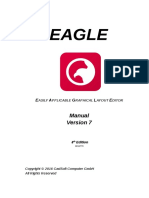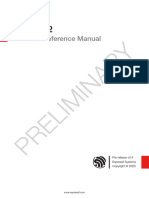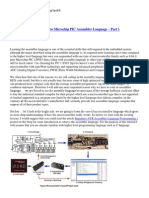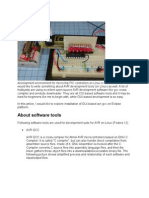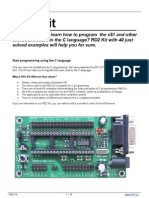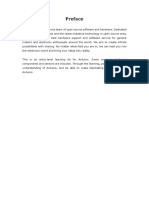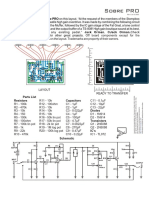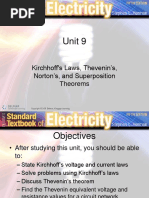Arduino Universal Input PCB V2
Uploaded by
m.baranArduino Universal Input PCB V2
Uploaded by
m.baranArduino universal 12x input PCB inputs; 0-20mA, 4-20mA 0-10V, 24V pushbutton, 24V PNP and NPN
sensors etc.
It is the best to build analog inputs to a separate PCB and digital (opto) inputs to another to get galvanic isolation.
4-20mA 0-20mA analog input 1
R1 R3 R4
4-20 A0 --- A5
R2 C1
Arduino Gnd
R1 = Jumper R4 = 2,2 kohm
R2 = 250 ohm R5 = ---
R3 = 10 kohm C1 = 1 uF polyester capacitor
Spacing 5mm
0-10V analog input 2
R1 R3 R4
0-10 A0 --- A5
R2 C1
Arduino Gnd
R1 = 4,7 kohm R4 = 2,2 kohm
R2 = 4,7 kohm R5 = ---
R3 = 10 kohm C1 = 1 uF polyester capacitor
Spacing 5mm
2-6V digital input 3
R1 R3 R4
1 5 Arduino +5
R2 C1 4 D2 --- D13
R5
CNY17-3
2 Arduino Gnd
R1 = Jumper R4 = Jumper
R2 = 1 kohm R5 = 2,2 kohm
R3 = 100 ohm C1 = 1 uF polyester capacitor
This text must be readable on copper side
Spacing 5mm
5-30V digital PNP input 4
Gnd +5V
R1 R3 R4
s 5 Arduino +5 R5
D2 R5
D3 D4
1 R5
PCB size 160 x 100 mm
R5 D5
R2 C1 4 D2 --- D13
R5 CNY-17-3 CNY-17-3 CNY-17-3 CNY-17-3
_ Arduino Gnd
CNY17-3
2 1
A0 Gnd A1 Gnd
1 1 1
R1 = Jumper R4 = Jumper
R4 R4 R4 R4 R4 R4
R2 = 4,7 kohm R5 = 2,2 kohm
R3 = 2,2 kohm C1 = 1 uF polyester capacitor
Spacing 5mm C1 C1 C1 C1 C1 C1
R3 R3 R3 R3 R3 R3
5-30V digital NPN input 5 Z1
R1 R3 R4 R1 R2 R1 R2 R1 R2 R1 R2 R1 R2 R1 R2 J1 Cut here
+ 5 Arduino +5 to make
1 NPN input
R2 C1 4 D2 --- D13
R5
3 2 1 4 4 5
s Arduino Gnd
CNY17-3
2
_ _ _ _ _ _
R1 = Jumper R5 = 2,2 kohm s + s + s + s + s + s
R2 = 4,7 kohm J1 = Jumper
R3 = 2,2 kohm Z1 = Cut the copper
R4 = Jumper C1 = 1 uF polyester capacitor s s
Spacing 5mm 0-10V
input
R3 & C1 generates a RC low pass filter, alter
as needed. R4 is to protect arduino inputs _ Push _
especially when connecting wires power on. _ + button +
s Inductive Inductive
_ _ Cut the copper where pointed with arrows Drilling Screw-connectors 1,5mm
This drawing is produced + s proximity + proximity
Battery to get a potential free optoisolated input Other components 0,6mm
with Inkscape program operated 4-20 mA
sensor PNP 24V pwr sensor NPN
sensor
for a self-powered device. PCB mounting holes 3mm
transmitter supply
running on Ubuntustudio
Markus Kantola A pushbutton goes between + and s
You might also like
- Experiment # 4: ESP32 ADC - Read Analog Values With Arduino IDE100% (2)Experiment # 4: ESP32 ADC - Read Analog Values With Arduino IDE6 pages
- Introduction To AVR Microcontrollers: College of EngineeringNo ratings yetIntroduction To AVR Microcontrollers: College of Engineering33 pages
- PS2® To Usb Mouse Translator Hardware Diagram100% (1)PS2® To Usb Mouse Translator Hardware Diagram10 pages
- ESP32 With BMP180 Barometric Sensor - GuideNo ratings yetESP32 With BMP180 Barometric Sensor - Guide7 pages
- Programming Attiny85 Programmer A Complete GuideNo ratings yetProgramming Attiny85 Programmer A Complete Guide11 pages
- Esp32-H2 Technical Reference Manual enNo ratings yetEsp32-H2 Technical Reference Manual en1,160 pages
- User Manual - SN-138020 - Atmega-8 Mother Board100% (1)User Manual - SN-138020 - Atmega-8 Mother Board11 pages
- Embedded Lab: Wireless Data Transmission Between Two PIC Microcontrollers Using Low-Cost RF ModulesNo ratings yetEmbedded Lab: Wireless Data Transmission Between Two PIC Microcontrollers Using Low-Cost RF Modules11 pages
- Nodemcu Esp32: Microcontroller Development Board100% (1)Nodemcu Esp32: Microcontroller Development Board6 pages
- Arduino Programming and Hardware Fundamentals With Hackster - Online Engineering CoursesNo ratings yetArduino Programming and Hardware Fundamentals With Hackster - Online Engineering Courses1 page
- Flipper Zero MAIN PCB 11.F7B9C6-SchematicNo ratings yetFlipper Zero MAIN PCB 11.F7B9C6-Schematic7 pages
- How To Use 24 TFT LCD Shield With Arduino Mega PDFNo ratings yetHow To Use 24 TFT LCD Shield With Arduino Mega PDF4 pages
- Bitfury B8 Open Miner: Quick Start GuideNo ratings yetBitfury B8 Open Miner: Quick Start Guide14 pages
- Installation - Scoppy - Oscilloscope and Logic Analyzer0% (1)Installation - Scoppy - Oscilloscope and Logic Analyzer1 page
- DC Motor Control With Rotary Encoder and PIC MCU - Mikroc ProjectsNo ratings yetDC Motor Control With Rotary Encoder and PIC MCU - Mikroc Projects1 page
- Is-FullVersion Kit For Arduino MEGA 2560-1No ratings yetIs-FullVersion Kit For Arduino MEGA 2560-1132 pages
- Vcc5V: GND P$1 GPIO - 2 P$16 D7 D8 D9 D11 D10No ratings yetVcc5V: GND P$1 GPIO - 2 P$16 D7 D8 D9 D11 D102 pages
- Optoway: SPS-2340WG / SPS-2340BWG / SPS-2340AWGNo ratings yetOptoway: SPS-2340WG / SPS-2340BWG / SPS-2340AWG5 pages
- Obsolete: Ultralow Noise 20-Bit Audio DAC AD1862No ratings yetObsolete: Ultralow Noise 20-Bit Audio DAC AD186212 pages
- Wireless For The Warrior, Various Series No. 4, Philips DR 30No ratings yetWireless For The Warrior, Various Series No. 4, Philips DR 305 pages
- Ieee Recommended Practice For Testing Insulation Resistance of R100% (1)Ieee Recommended Practice For Testing Insulation Resistance of R27 pages
- Milestone 3 Trade Project Report Sample GuideNo ratings yetMilestone 3 Trade Project Report Sample Guide34 pages
- Chapter 1 - Introduction To Process Control (I-Learn)No ratings yetChapter 1 - Introduction To Process Control (I-Learn)11 pages
- NAS-6-RA04-EE030-0004-SD-01-01-R02-Code BNo ratings yetNAS-6-RA04-EE030-0004-SD-01-01-R02-Code B1 page
- Design and Simulation of 20 MVAR Three Phase Shunt Reactor For Voltage Suppression at 230 KV Transmission Line (Kyaukpyu Primary Substation)100% (1)Design and Simulation of 20 MVAR Three Phase Shunt Reactor For Voltage Suppression at 230 KV Transmission Line (Kyaukpyu Primary Substation)10 pages
- CIGRE US National Committee 2017 Grid of The Future SymposiumNo ratings yetCIGRE US National Committee 2017 Grid of The Future Symposium9 pages
- KD F Series Family: Kyocera KD Modules ReliableNo ratings yetKD F Series Family: Kyocera KD Modules Reliable2 pages
- Experiment No: 03: Name of The ExperimentNo ratings yetExperiment No: 03: Name of The Experiment4 pages
- Chapter 1 Introduction and Overview of Electrode ProcessesNo ratings yetChapter 1 Introduction and Overview of Electrode Processes56 pages
- Isp - 07Nt: Automatic Controller of Cutting Thickness For Conveyor Cutting MachinesNo ratings yetIsp - 07Nt: Automatic Controller of Cutting Thickness For Conveyor Cutting Machines13 pages








